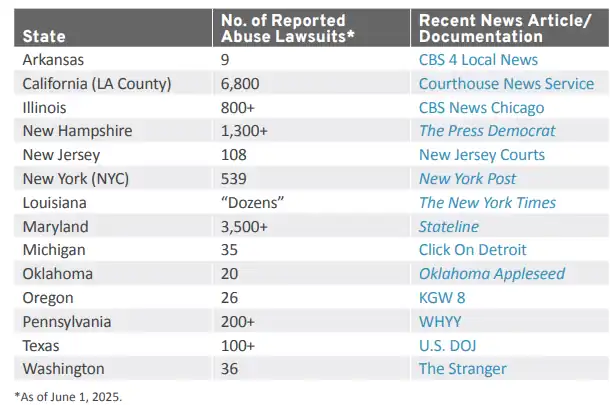A new policy report published by the Annie E. Casey Foundation, authored by criminal justice researcher, Logan Seacrest, a resident fellow at R Street Institute, warns that sexual abuse in America’s juvenile detention system is far more pervasive than previously recognized. The full report (available here), titled Abused by the State: The Hidden Crisis Inside America’s Juvenile Detention System, reveals that thousands of youth have suffered sexual abuse at the hands of staff and peers, triggering a wave of lawsuits and billions of dollars in potential settlements against states and counties.
A Widespread Problem
On any given day, approximately 27,000 children and teens are held in juvenile detention centers across the United States. Despite declining youth incarceration rates over the past 25 years, reports of sexual abuse have only grown. A Bureau of Justice Statistics survey in 2018 found that more than 7 percent of detained youth reported being sexually victimized, a rate higher than adults in prison. Investigations revealed grooming tactics, threats of solitary confinement, and staff leveraging privileges or substances to exploit youth. Troublingly, the majority of serious staff-on-youth sexual misconduct cases involved female staff members. Yet fewer than one in ten allegations are substantiated, and criminal charges are rare.
Failures of the Prison Rape Elimination Act
The federal Prison Rape Elimination Act (PREA), passed in 2003, was intended to reduce sexual abuse in correctional settings. But since PREA standards took effect, reports of sexual victimization in juvenile facilities have increased by nearly 90 percent. The report argues that PREA lacks enforcement power, fails to protect whistleblowers, and has created a patchwork of compliance with little accountability.
Delayed Justice and Legal Fallout
Because many survivors delay disclosure of childhood sexual abuse until adulthood, the true scope of abuse in detention facilities is only now emerging. Legislative reforms in dozens of states have extended or eliminated statutes of limitations, while revival laws have allowed survivors to file previously expired claims. In 2022, Congress eliminated the civil statute of limitations for federal cases. The result has been an avalanche of litigation. New Hampshire, Maryland, and California alone are facing billions in liabilities, with Los Angeles County tentatively agreeing to a record-setting $4 billion settlement in 2025.

Staffing Crisis and Unsafe Conditions
The report also points to severe staffing shortages in juvenile detention centers nationwide. Vacancy rates of 30 to 40 percent have forced facilities to lower hiring standards and cut back on supervision. Underqualified staff and high turnover have undermined rehabilitation efforts and increased risks of abuse. In some cases, youth have been confined to cells for days at a time because of staffing shortages, leading to unsafe and degrading conditions. Violent incidents in understaffed facilities have drawn federal scrutiny and Department of Justice warnings.
Policy Recommendations
The foundation calls for a “zero-tolerance” approach to sexual abuse in youth detention. Key recommendations include tying PREA compliance to meaningful financial consequences, establishing independent oversight, improving whistleblower protections, raising hiring standards, upgrading surveillance technology, and shrinking the overall footprint of secure detention. The report stresses that the best protection against institutional abuse is to reduce unnecessary incarceration altogether and invest in community-based alternatives.
Conclusion
The findings paint a grim picture of systemic failure. For decades, sexual abuse in juvenile facilities was hidden behind statutes of limitations, institutional secrecy, and dismissive oversight. With thousands of survivors now coming forward, states are facing both legal reckoning and fiscal crisis. According to the report, the only way to restore trust and protect children is through accountability, transparency, and a commitment to reducing detention itself.
Survivors of institutional sexual abuse deserve justice. If you or a loved one suffered abuse in a juvenile detention facility, you may still have legal options. Learn more by visiting our Institutional Sexual Abuse Guide today.




